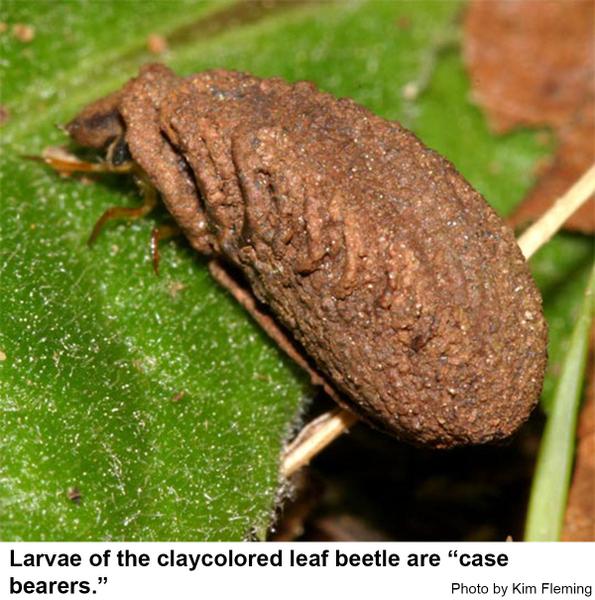Description and Biology
Claycolored leaf beetles, Anomoea laticlavia, are ⅜ inch long, brown to redish brown with a dark line down the inner and outer edges of the wing covers. They feed on a broad range of host trees and shrubs although it is sometimes called the persimmon beetle. In North Carolina our records are primarily from persimmon. Matthew St Pierre and his colleagues found that although this beetle is found from the Great Plains eastward, it does not disperse rapidly. In the prairie habitat, this beetle seems to feed only on lead plant, Amorpha canescens. Females lay their eggs in cases of fecal material on the ground or on foliage. The larvae of claycolored leaf beetles are case-bearing, that is, they wear a pouch or case made of frass and bits of leaves. I predict they pupate inside the case when fully grown. The larvae likewise feed on leaves (the larvae of many other leaf beetles feed naked on leaves or on roots under ground). We have one generation per year.
Host Plants
In North Carolina most of our records are from persimmon. Elsewhere in the Southeast it has been found on azalea, oak, willow, and wisteria. In the Great Plains the claycolored leaf beetle seems to feed only on lead plant, Amorpha canescens.
Recommendation
Bifenthrin, permethrin, or one of the other pyrethroids labeled for insect control in landscapes should give more than adequate control of claycolored leaf beetles. Pyrethroids are toxic to many insects, and are also repellent to insects so the tree will be unattractive to other beetles and bees after it has been treated. When used as directed, pyrethroids are very toxic to insects but are not particularly hazardous to humans and pets (other than fish-avoid using pyrethroids around pools, ponds, and streams).
References
- Species Anomoea laticlavia - Clay-colored Leaf Beetle. DiTerlizzi, T., P. Coin, M. Quinn, and Marcie OConner. 2022 (update). BugGuide. Iowa State University, Dept. Entomology.
- Dispersal ability and host-plant characteristics influence spatial population structure of monophagous beetles. St. Pierre, M. J., S. D. Hendrix, and C. K. Lewis. 2005. Ecological Entomology 30: 105-115.
- Extension Plant Pathology Publications and Factsheets
- Horticultural Science Publications
- North Carolina Agricultural Chemicals Manual
For assistance with a specific problem, contact your local N.C. Cooperative Extension Center.
This Factsheet has not been peer reviewed.
Publication date: June 10, 2015
Reviewed/Revised: Jan. 9, 2025
Recommendations for the use of agricultural chemicals are included in this publication as a convenience to the reader. The use of brand names and any mention or listing of commercial products or services in this publication does not imply endorsement by NC State University or N.C. A&T State University nor discrimination against similar products or services not mentioned. Individuals who use agricultural chemicals are responsible for ensuring that the intended use complies with current regulations and conforms to the product label. Be sure to obtain current information about usage regulations and examine a current product label before applying any chemical. For assistance, contact your local N.C. Cooperative Extension county center.
N.C. Cooperative Extension prohibits discrimination and harassment regardless of age, color, disability, family and marital status, gender identity, national origin, political beliefs, race, religion, sex (including pregnancy), sexual orientation and veteran status.



